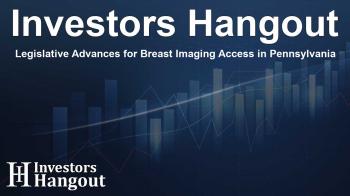Legislative Advances for Breast Imaging Access in Pennsylvania

New Legislative Changes for Breast Imaging Accessibility
In a significant move to improve healthcare access, new legislation is set to benefit individuals needing breast imaging services. The recent collaboration between Representative Gina Curry and healthcare advocacy groups aims to eliminate the financial burdens often associated with diagnostic and supplemental imaging. This is crucial as many individuals currently face significant out-of-pocket costs that deter them from receiving essential medical care.
The Importance of Accessible Breast Imaging
Thousands of lives are at risk due to financial limitations on health care. Each year, a staggering number of individuals receive breast cancer diagnoses, accounting for a considerable health crisis. Unfortunately, these patients often must choose between their health and their finances. The costs associated with necessary procedures, including MRI scans and ultrasounds, can reach into the thousands, making early detection challenging for those who need it most.
Statistical Impact on Communities
Statistical projections estimate that over 13,650 individuals will receive a breast cancer diagnosis in the near future. Alarmingly, around 1,800 of these individuals may lose their lives to this disease in the subsequent year. The financial implications of diagnostic imaging play an undeniably vital role in either facilitating timely intervention or delaying necessary treatments, exacerbating an already dire situation.
Transforming the Landscape of Healthcare
Molly Guthrie, the Vice President of Policy and Advocacy, expressed deep concern regarding the current barriers faced by patients. "No one should have to skip vital medical care due to its cost," she stated, underlining the necessity for legislative reforms that prioritize patient needs over financial hurdles. The proposed bills aim to create an environment where medical interventions can be accessed freely, thus promoting equitable healthcare for all patients.
Understanding the Financial Barriers
The absence of insurance coverage for specific diagnostic procedures often means that individuals may need to pay out of pocket. A recent study showcased that costs could range significantly, with some patients facing charges as low as $234 for mammograms to over $1,000 for MRIs. These figures highlight the urgent need for reforms that address these financial disparities and promote early intervention strategies.
Insights from Legislative Advocacy
Leaders like Representative Gina Curry are advocating for guidelines that ensure no patient has to make the financially burdensome choice of foregoing essential follow-up procedures. "By abolishing out-of-pocket costs, we reaffirm our commitment to improving healthcare outcomes while also safeguarding our community's health," Curry stated. This is not just about healthcare reform; it's about ensuring that lives are saved through proper early detection.
The Call to Action
As more attention is drawn toward the need for accessible healthcare, advocacy groups encourage the public to urge their representatives to support legislation that favors patient welfare. Increased awareness within communities can drive change, leading to more individuals receiving the screening and care needed to fight breast cancer.
About Susan G. Komen
Susan G. Komen stands as a pivotal organization in the realm of breast cancer awareness and research. This nonprofit organization continues to work tirelessly towards the goal of eradicating breast cancer, providing resources and support for affected individuals. Their comprehensive approach includes advocacy for patients, significant contributions to research, and enhancement of access to quality healthcare. Founded by Nancy G. Brinker in memory of her sister Susan G. Komen, the organization is committed to improving patient outcomes and driving forward solutions to battle this pervasive illness. For more information, those interested can explore their extensive offerings at komen.org or connect with them via social media platforms.
Frequently Asked Questions
What is the goal of the new legislation in Pennsylvania?
The legislation aims to remove financial barriers to diagnostic and supplemental breast imaging, ensuring that individuals receive necessary screenings without incurring high out-of-pocket costs.
How many people are affected by breast cancer in Pennsylvania each year?
It's estimated that over 13,650 individuals will be diagnosed with breast cancer annually within the state.
What types of imaging procedures are being addressed in this legislation?
Procedures such as breast MRIs and ultrasounds, which are critical for diagnosis and follow-up, are the primary focus of this legislation.
Who is leading the charge for this legislative change?
Representative Gina Curry is playing a key role in advocating for and introducing these significant legislative changes.
How can individuals support this cause?
Individuals can support the cause by raising awareness, contacting their representatives, and advocating for patient-centered healthcare reforms.
About The Author
Contact Henry Turner privately here. Or send an email with ATTN: Henry Turner as the subject to contact@investorshangout.com.
About Investors Hangout
Investors Hangout is a leading online stock forum for financial discussion and learning, offering a wide range of free tools and resources. It draws in traders of all levels, who exchange market knowledge, investigate trading tactics, and keep an eye on industry developments in real time. Featuring financial articles, stock message boards, quotes, charts, company profiles, and live news updates. Through cooperative learning and a wealth of informational resources, it helps users from novices creating their first portfolios to experts honing their techniques. Join Investors Hangout today: https://investorshangout.com/
The content of this article is based on factual, publicly available information and does not represent legal, financial, or investment advice. Investors Hangout does not offer financial advice, and the author is not a licensed financial advisor. Consult a qualified advisor before making any financial or investment decisions based on this article. This article should not be considered advice to purchase, sell, or hold any securities or other investments. If any of the material provided here is inaccurate, please contact us for corrections.

